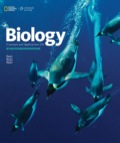
Introduction:
All the substances present in the environment are composed of elements. Biologist gave a sequence of an organization that is followed by every substance. This is known as the “level of organization.”
Answer to Problem 1SQ
Correct answer:
The fundamental building blocks of all matter are atoms. Hence, the correct answer is option a.
Explanation of Solution
Reason for correct answer:
Option a. is given as “Atoms”
The basic level of the organization includes “atoms, molecules, cells, tissues, organs, organ system, organisms, population, community, ecosystem, and biosphere.” The basic, fundamental building blocks that form all matter is an atom. The interaction of atoms results in the formation of molecules. Molecules interact to form cells. The cell is the basic “fundamental unit” of every living organism. The cellular interaction forms tissues and tissues link together to form organs. This formation cycle continues to grow and ultimately forms biosphere. The biosphere is the largest level of organization, and it contains all the substances (both living and non-living) that are present in the environment. Hence, option a. is correct.
Reason for incorrect answer:
Option b. is given as, “Molecules.”
Molecules are one of the smaller units that form substance. However, they are not the fundamental one. Molecules are formed by the interaction of atoms. This indicates that molecules are not the fundamental building blocks of all matter.
Hence, option b. is incorrect.
Option c. is given as, “Cells.”
Cells are the basic “fundamental unit” of life. They are the smallest unit for the formation of organisms but not mater. Cells are formed by molecules, and molecules are composed of atoms. This indicates that cells are not the fundamental building blocks of all matter. Hence, option c. is incorrect.
Option d. is given as “Organisms.”
Organisms are larger units. They contain cells, tissues, organ, and organ system. The basic unit that forms an organism is a cell. However, atoms are the building blocks of the cell. This indicates that organisms are not the fundamental building blocks of all matter. Hence, option d. is incorrect.
Hence, the options b, c, and d are incorrect.
Atoms are the fundamental building blocks of all matters. Thus, the correct option is a.
Want to see more full solutions like this?
Chapter 1 Solutions
EBK BIOLOGY: CONCEPTS AND APPLICATIONS
- An adult human body consists of about__________________ cells. a. 2 billion c. 30 trillion b. 50 billion d. 8 quadrillion.arrow_forwardThe smallest unit of biological structure that meets the functional requirements of “living” is the ________. a. organ b. organelle c. cell d. macromoleculearrow_forwardA___ is two or more atoms joined together A. Cell B. Tissue C. Molecule D. Particlearrow_forward
- _______________________ is the molecule within a cell that actually assembles proteins from amino acids. a. An enzyme b. The nucleus c. RNA d. ALH84001 e. PAHarrow_forwardWhich of the listed terms is described by: “All the chemical processes that take place in the organelles and cytoplasm the cells of the body"? A. Metabolism B. Cellular respiration C. Homeostasis D. Physiologyarrow_forwardTwo or more types of tissues grouped together and performing specialized functions defines a(n) ___________. a. organelle b. cell c. organ d. organ systemarrow_forward
- The main function of RNA is to __________________. a. Store food b. Create energy c. Break apart carbohydrates d. Build proteinsarrow_forwardPrecursor to vitamin A.* A. Retinol B. Retinoic acid C. Carotene D. Tocopherolarrow_forwardWhich of the following imaging techniques would be best to use to study the uptake of nutrients by rapidly multiplying cancer cells? a. CT b. MRI c. PET d. ultrasonographyarrow_forward
- The smallest unit of life is the______ .a. atom c. cell b. molecule d. organismarrow_forwardThe protein spectrin found in the cortex of red blood cells functions as ______________. Select one: a. a transporter b. a structural protein c. an enzyme d. a receptor e. a hormonearrow_forwardAll cells have DNA (genetic material). A.True B. Falsearrow_forward
 Human Anatomy & Physiology (11th Edition)BiologyISBN:9780134580999Author:Elaine N. Marieb, Katja N. HoehnPublisher:PEARSON
Human Anatomy & Physiology (11th Edition)BiologyISBN:9780134580999Author:Elaine N. Marieb, Katja N. HoehnPublisher:PEARSON Biology 2eBiologyISBN:9781947172517Author:Matthew Douglas, Jung Choi, Mary Ann ClarkPublisher:OpenStax
Biology 2eBiologyISBN:9781947172517Author:Matthew Douglas, Jung Choi, Mary Ann ClarkPublisher:OpenStax Anatomy & PhysiologyBiologyISBN:9781259398629Author:McKinley, Michael P., O'loughlin, Valerie Dean, Bidle, Theresa StouterPublisher:Mcgraw Hill Education,
Anatomy & PhysiologyBiologyISBN:9781259398629Author:McKinley, Michael P., O'loughlin, Valerie Dean, Bidle, Theresa StouterPublisher:Mcgraw Hill Education, Molecular Biology of the Cell (Sixth Edition)BiologyISBN:9780815344322Author:Bruce Alberts, Alexander D. Johnson, Julian Lewis, David Morgan, Martin Raff, Keith Roberts, Peter WalterPublisher:W. W. Norton & Company
Molecular Biology of the Cell (Sixth Edition)BiologyISBN:9780815344322Author:Bruce Alberts, Alexander D. Johnson, Julian Lewis, David Morgan, Martin Raff, Keith Roberts, Peter WalterPublisher:W. W. Norton & Company Laboratory Manual For Human Anatomy & PhysiologyBiologyISBN:9781260159363Author:Martin, Terry R., Prentice-craver, CynthiaPublisher:McGraw-Hill Publishing Co.
Laboratory Manual For Human Anatomy & PhysiologyBiologyISBN:9781260159363Author:Martin, Terry R., Prentice-craver, CynthiaPublisher:McGraw-Hill Publishing Co. Inquiry Into Life (16th Edition)BiologyISBN:9781260231700Author:Sylvia S. Mader, Michael WindelspechtPublisher:McGraw Hill Education
Inquiry Into Life (16th Edition)BiologyISBN:9781260231700Author:Sylvia S. Mader, Michael WindelspechtPublisher:McGraw Hill Education





